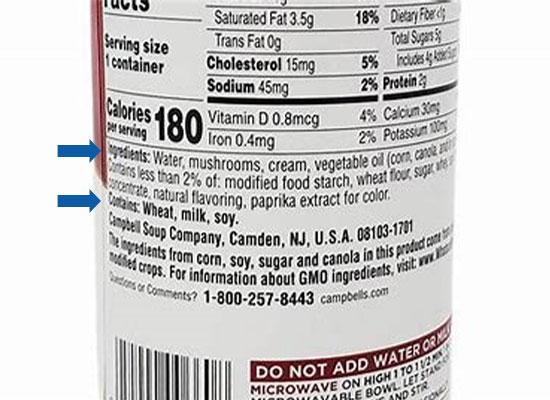 Contact
About Us
Articles
Home
Contact
About Us
Articles
Home

About 40 million Americans are lactose intolerant or cannot digest the milk sugar lactose. This type of issue is not necessarily concerning compared to other health conditions. However, it can impact the health of individuals since consuming certain dairy products can cause discomfort and painful gastrointestinal symptoms. If a person does not know that they have lactose intolerance, then they may not stop consuming such foods and in turn their quality of life can decrease.
Research shows that older adults over the age of 65 years are more likely to develop lactose intolerance as they age. This is because there is a gradual decline in lactase enzyme as one grows older. Therefore, even though you may have had no trouble with lactose-containing foods or digestive issues in younger age, this does not necessarily mean that you will not develop lactose intolerance later in life.
Fortunately, there are many ways to help diagnose lactose intolerance and various methods, both dietary and medicinally that can help manage symptoms of lactose intolerance. It's important to understand what lactose intolerance is, symptoms of this issue, ways to diagnose and treat it, foods that are low in lactose and lactose-free alternatives to your favorite lactose-containing foods.
Lactose intolerance occurs when a person does not develop enough or any of the enzyme lactase. Lactase helps the body to break down lactose, which is a sugar found in cow's milk and cow's milk products. When the body cannot break down lactose, it can cause uncomfortable gastrointestinal symptoms as we'll discuss.
Lactose intolerance is not a milk allergy since food allergies are known for causing an immune response to a protein in foods when eaten. Allergies will cause symptoms such as rash, swelling of the tongue, difficulty swallowing or trouble breathing. On the other hand, food intolerances cause digestive-related symptoms that usually start within hours of eating a food. If you have a more severe food intolerance, you might notice these symptoms sooner. And unlike food allergies, food intolerances are not life-threatening, just painful and uncomfortable at times.
Not everyone may be aware that there are multiple types of lactose intolerance that have different causes. Treatment is pretty much the same for all four types, except those that have no lactase at all in their body will not be able to tolerate even small amounts of lactose. The four main types of lactase deficiency include:
This type of lactase deficiency is hereditary and develops in adolescence and early adulthood versus the more common developmental in older age. This type of lactase deficiency occurs when lactase levels start decreasing as early as infancy.
Secondary lactase deficiency occurs when a chronic infection of illness damages the lining of your intestines and in turn causes lactase deficiency. Certain health conditions that can cause secondary lactase deficiency include gastroenteritis, celiac disease, Crohn's disease and ulcerative colitis. In addition to these conditions, chemotherapy and antibiotics can lead to secondary lactase deficiency.
This rare form of lactase deficiency typically develops in infancy, due to inheritance, after the ingestion of milk. Those with this condition can have a lack of or complete absence of lactase.
Some premature infants can develop lactase deficiency at around 28 to 37 weeks of gestation because of their intestines not becoming fully developed. The positive part is that people with this type of lactase deficiency can grow out of it as the intestines mature.
Some people may have symptoms have lactose intolerance without knowing that they are lactose intolerant. I will often have patients tell me that drinking milk causes stomach pain, so they avoid consuming it. They will complain of bloating and gas after eating but recall no food allergies or intolerances. Or when asked if they want to try a protein shake, they will say, “No, those things cause me diarrhea.” These statements and reports are often small clues that this person may have some form of lactose intolerance.
Common symptoms of lactose intolerance include:
If you have symptoms of lactose intolerance, then you can visit your doctor and ask about different tests that can confirm that you have lactose intolerance. Such testing methods include:
If you have symptoms that are impacting your quality of life, and you notice such symptoms after eating or drinking lactose-rich foods, then don't wait to limit your lactose intake. Start avoiding such foods and drinks that give you symptoms and see if you start feeling better. This is because it may take you a while to obtain an appointment to get such specialized tests done since a gastrointestinal doctor must perform such tests for the most accurate result.
And if your symptoms continue after not eating lactose-containing foods and drinks, then your symptoms may be a result of another health issue. For example, certain conditions such as Crohn's disease, celiac disease and bacterial overgrowth can have similar symptoms as lactose intolerance.

You can treat lactose intolerance by limiting the lactose-containing foods you consume in your daily routine. Foods that contain lactose include cow's milk and cow's milk-based products such as yogurt, cottage cheese, cream, cream-based soups, whipped cream and ice cream, for example.
There are certain companies like Lactaid® and Green Valley™ Creamery that provide lactose-free versions of cottage cheese, milk, ice cream and sour cream, for example.
There are also lactase enzyme medicines that you can take in tablet or chewable form that can help you digest dairy. Some research also shows that some types of probiotics may be helpful in reducing and managing symptoms of lactose intolerance.
And experts suggest that those with lactose intolerance may be able to eat small portions of lactose-containing foods. You will learn more about the lactose content of foods later in the article.
Since cow's milk is a good source of protein for many people, those with lactose intolerance may be at risk for developing nutrient deficiencies like low calcium. However, it's important to know that outside of dairy products, there are other good sources of calcium that someone can consume to obtain the daily recommended intake of calcium.
The average adult should consume about 1,000 milligrams (mg) of calcium daily. Older adults at the age of 51 to 70 years of age should consume between 1,000 mg and 1,200 mg of calcium daily, while those older than 70 years should consume 1,200 mg of calcium daily.
Milk and yogurt each contain about 300 mg of calcium per cup, while cottage cheese contains about 138 mg of calcium per cup. However, when it comes to non-dairy sources of calcium, the following foods are good sources of calcium that those with lactose intolerance could benefit from.
If you find that you don't consume a lot of these foods, then it may be best to consume lactose-free dairy products daily and/or ask your health care provider for a calcium supplement. You will most likely need to take a vitamin D supplement along with your calcium supplement since vitamin D helps your body best absorb calcium.
Most adults should consume about 600 IU of vitamin D daily. You can obtain and adequate amount of vitamin D by consuming vitamin D enriched milks, juices, and cereals, and/or spending ample time outdoors in the sunshine.
Vitamin D and calcium are labs you should check each year at your health care provider's annual visit to make sure you are within normal range. If you happen to be low in these labs, then the doctor can prescribe you the appropriate dosage of such nutrients.
If you are lactose intolerant, it doesn't mean that you can never have a food or drink containing lactose ever again. In fact, research shows that those with lactose intolerance can typically tolerate about 12 grams of lactose each day. Read below to learn more about the lactose content of some common foods.
By looking at this list, it's clear that milk is not something that someone with lactose intolerance can tolerate unless they only have a small portion or consume lactase supplements with it. If you want to consume larger portions of foods and drinks that contain lactose, then it is safer to choose lactose-free dairy products or plant-based milks and yogurts.
Other foods that are low in lactose include:

There is no lactose in meat, poultry, seafood, fish, grains, vegetables, fruits or oils unless a food product is flavored or prepared with a milk-containing ingredient. An example of such a food containing lactose would be a fish coated and baked with a milk-based seasoning powder or a pasta dish containing a cream-based sauce, or a bread product baked with milk. Be sure to check the ingredient label of pre-packaged products to check for milk-based ingredients. See this label to find out where to look for this information.
Some labels may say a product contains milk derivatives, but these ingredients are typically in amounts small enough to be low in lactose. If you are not sure if a product contains lactose, you can always check the company website or ask your doctor or dietitian for more information. You can also check out this article that provides tips on how to read labels on food and drink products and figure out if they contain dairy or not.
There is no proven cure for lactose intolerance. Some research suggests slowly reintroducing dairy into the daily diet to help your body build up the microbiome to handle lactose. However, there is limited research to confirm any such findings. Therefore, if you exhibit symptoms of lactose intolerance or have a diagnosis of lactose intolerance, simply follow the tips above to reduce lactose in your daily routine to help manage symptoms.
And don't forget to call your health insurance company to see if there are any programs that will help you purchase the medicines and foods you may need to help manage your lactose intolerance. If you have a flexible spending account or something similar, you can usually use that account to purchase items like digestive aids and over-the-counter medicines.
Alliance America is an insurance and financial services company dedicated to the art of personal financial planning. Our financial professionals can assist you in maximizing your retirement resources and achieving your future goals. We have access to an array of products and services, all focused on helping you enjoy the retirement lifestyle you want and deserve. You can request a no-cost, no-obligation consultation by calling (833) 219-6884 today.


